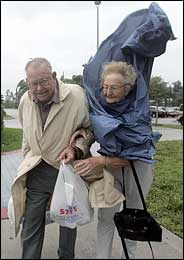Jim Whitaker is the director of a documentary in the making of the changes taking place at the World Trade Center site. Project Rebirth, as it’s called, has been taking time lapse imagery from various cameras perched on buildings surrounding the site since the Spring of 2002, after most debris was cleared away from The Bathtub.
Now, in time for the third anniversary of the attacks, they’ve released a trailer, some time lapse segments, and a webcam. Begun with an imperative to capture History and only a bare conception of what it might actually look like, the filmmakers added street-level and firehouse cameras later on.
Which is interesting, because by definition, human presence, the individual, is rendered invisible in a multi-year time lapse. Like Hiroshi Sugimoto’s movie screen photographs, which are exposed for the duration of a film. Technically, the resulting image “contains” all the information in the film, but the screen itself is pure white. Meanwhile, the minutest details of the theaters–architecture, seats, stages, curtains–emerge from the darkness only because of the projected film.
projectrebirth.org
Ground Zero, The Long View [Sarah Boxer, NYT]
Now Playing at Les Arenes de Chaillot
The Guardian’s Jon Henley talks with members of La Mexicaine de Perforation, the urban explorers group who built and operated a cinema in a 4,000-sf uncharted quarry 60 feet under the Place de Chaillot in Paris. They called the cinema Les Arenes de Chaillot.
During the seven-week season, the Mexicans screened films by “Chinese and Korean directors but also Alex Proyas’ Dark City, Coppola’s Rumble Fish, David Lynch’s Eraserhead, and Terry Gilliam’s Brazil.
Clandestine group reveals how it built its cinema beneath the city [Guardian UK]
Now Playing at Les Arenes de Chaillot
The Guardian’s Jon Henley talks with members of La Mexicaine de Perforation, the urban explorers group who built and operated a cinema in a 4,000-sf uncharted quarry 60 feet under the Place de Chaillot in Paris. They called the cinema Les Arenes de Chaillot.
During the seven-week season, the Mexicans screened films by “Chinese and Korean directors but also Alex Proyas’ Dark City, Coppola’s Rumble Fish, David Lynch’s Eraserhead, and Terry Gilliam’s Brazil.
Clandestine group reveals how it built its cinema beneath the city [Guardian UK]
Like Watching Wallpaper Dry
Wallpaper* founding editor Tyler Brule will host and produce The Desk, BBC4’s “long awaited media show,” a media-gazing TV gig even more prestigious than, say, Topic A with Tina Brown.
Brule’s strategy for getting the slot may give a hint of what to come; according to the Guardian, Brule first had to beat off some stiff challengers, and “he also beat off other more experienced media experts including Loaded founder James Wheeler, author Paul Morley and Newsnight’s Kirsty Wark.”
Apparently, so many people wanted to try their hand at the low-paying job because it’s been a stepping stone for careers in television. I was going to try to squeeze a couple more jokes out of this, but I think I’ll stop here.
Wallpaper man wraps up BBC media role [Media Guardian, via mediabistro]
It takes a village planner, Brule’s imaginary neighborhood shop-a-thon for NYT’s T
Like Watching Wallpaper Dry
Wallpaper* founding editor Tyler Brule will host and produce The Desk, BBC4’s “long awaited media show,” a media-gazing TV gig even more prestigious than, say, Topic A with Tina Brown.
Brule’s strategy for getting the slot may give a hint of what to come; according to the Guardian, Brule first had to beat off some stiff challengers, and “he also beat off other more experienced media experts including Loaded founder James Wheeler, author Paul Morley and Newsnight’s Kirsty Wark.”
Apparently, so many people wanted to try their hand at the low-paying job because it’s been a stepping stone for careers in television. I was going to try to squeeze a couple more jokes out of this, but I think I’ll stop here.
Wallpaper man wraps up BBC media role [Media Guardian, via mediabistro]
It takes a village planner, Brule’s imaginary neighborhood shop-a-thon for NYT’s T
2004-09-13, This Week in The New Yorker
![]()
Issue of 2004-09-13
Posted 2004-09-06
THE TALK OF THE TOWN
COMMENT/ IN MODERATION/ Hendrik Hertzberg compares the face of the Republican Party to its platform.
DEPT. OF DISCOURSE/ CIVIL DISOBEDIENCE/ Ben McGrath roams the Republican Convention.
GIVERS/ MONEY HONEYS/ Lillian Ross rubs elbows with the rhinestone Republicans.
ON THE AIR/ YOUNG AMERICANS/ Dana Goodyear on a group of preteen pundits.
CAMPAIGN JOURNAL/ Philip Gourevitch/ Bushspeak/ How the President works the crowds.
SHOUTS & MURMURS/ Paul Rudnick/ Running Mates
PROFILES/ David Remnick/ The Wilderness Campaign/ Al Gore, four years later.
FICTION/ Marilynne Robinson/ “Kansas”
THE CRITICS
BOOKS/ Thomas Mallon/ Golden Boy/ The life and letters of Truman Capote.
A CRITIC AT LARGE/ Adam Gopnik/ Will Power/ Why Shakespeare remains the necessary poet.
THE SKY LINE/ Paul Goldberger/ Homes of the Stars/ A high-profile suburb for the Hamptons.
THE CURRENT CINEMA/ David Denby/ Journeys
Vincent Gallo’s new movie, and an F. W. Murnau retrospective.
FROM THE ARCHIVE
OUR FAR-FLUNG CORRESPONDENTS/ Truman Capote/ A Ride Through Spain/ Capote’s first piece for the magazine/ Issue of 1950-09-02
ONLINE ONLY/ An interview with Paul Goldberger.
ONLINE ONLY: Q & A/ A Writer’s Time/ Marilynne Robinson discusses her first piece of fiction in two decades.
Animated Typography: Not My Type IV, by The Lycette Bros.
 Also worth checking out from Strange Attractors is Mark & John Lycette’s Not My Type IV. Although it dates from 2002, it’s just started getting attention and awards from festivals this year.
Also worth checking out from Strange Attractors is Mark & John Lycette’s Not My Type IV. Although it dates from 2002, it’s just started getting attention and awards from festivals this year.
The Lycettes’ Not My Type series uses typographic elements to create pared down characters and landscapes. A comma becomes a teardrop falling from o-within-O eyes, for example. Very smart, not cheesy stuff; it’s the best animated typography since Donald visited Mathmagicland.
That said, the pacing drags a little; when the protagonist gets annoyed at the whining leafblower, you feel something stronger than just empathy. Very nice stuff that makes me want to see I-III.
Not My Type IV by the Lycette Brothers [Strange Attractors, ABC]
Lycette Bros. studio site
Developing a Storyboard [Note: that untraceable typewriter sound is coming from an embedded Flash image waayy down the page that looks just like the jpgs around it. Flash is the new midi, apparently.]
The Way by Qing Huang, and 11 other AU animations
 Strange Attractors is a showcase of short films by 12 Victoria (Australia) animation artists sponsored by the Australian Broadcasting Corp. It looks very promising, in that “utter absence of commercial pressure=trippier than normal animation” kind of way.
Strange Attractors is a showcase of short films by 12 Victoria (Australia) animation artists sponsored by the Australian Broadcasting Corp. It looks very promising, in that “utter absence of commercial pressure=trippier than normal animation” kind of way.
Surfing through the offerings, bios and highly particular technical/instructional articles, the first film I decided to watch was Qing Huang’s The Way.
The Way is a beautiful 3-d cgi transformation of traditional Chinese painting that explores the Taoist’s view of art and nature. Although it’s all done in Maya, not actual stop action animation, it reminds me of the best aspects of William Kentridge’s work (i.e., the unification of technique and aesthetic, drawing/erasing and brushstroke, not the heavy-handed political melodrama.)
Watch it before reading Qing’s meticulously conceived philosophical approach to the project, if only to realize how, unlike so many of Kentrige’s works, the Big Message doesn’t overwhelm the film’s expert, enjoyable lyricism.
Strange Attractor [lo-band entry, easier than flash, via MeFi]
Painterly Effects in Maya, by Qing Huang [Strange Attractor, ABC]
Almost like TiVO for Public Radio
I just assume that everyone knows about PublicRadioFan.com, Kevin A. Kelly’s up-to-the-minute online programming guide for public radio stations.
The more I listen to radio online, the more frequently I find myself crafting my own programming schedule; I’ll listen to All Things Considered on Pacific Time, and This American Life and other weekend programs whenever I want by finding a fresh stream from some station, somewhere. The only problem is when you get in the car, and the local station is playing a show you’ve already heard.
Scott Sforza’s The Passion
“President Bush’s chief political strategist, Karl Rove, told CNN he did not think the podium’s decorative woodwork looked like a cross.
“‘My God, where do they come up with this stuff?’ he said. ‘Does it look to you like it’s a cross? I don’t think so.'”
– Jewish Groups Irked by Cross on Republican Podium [Reuters, 9/1/04]
And he said, Unto you it is given to know the mysteries of the kingdom of God: but to others in parables; that seeing they might not see, and hearing they might not understand.
– Luke 8:10, KJV
“Beside the podium is the gavel stand [which holds a gavel, the symbol of judgment, oh, and by the way, Jesus is the Judge. -g] constructed of wood panels, with lighter shades in the center in the shape of a cross — the Christian symbol of the crucifixion of Jesus.” [Reuters]
Not to be all nit-picky, but since Jesus Himself makes the distinction: if that gavel stand symbolizes Christ The Judge, then the speaker is on His Left Hand.
[via The Revealer]
Scott Sforza’s The Passion
“President Bush’s chief political strategist, Karl Rove, told CNN he did not think the podium’s decorative woodwork looked like a cross.
“‘My God, where do they come up with this stuff?’ he said. ‘Does it look to you like it’s a cross? I don’t think so.'”
– Jewish Groups Irked by Cross on Republican Podium [Reuters, 9/1/04]
And he said, Unto you it is given to know the mysteries of the kingdom of God: but to others in parables; that seeing they might not see, and hearing they might not understand.
– Luke 8:10, KJV
“Beside the podium is the gavel stand [which holds a gavel, the symbol of judgment, oh, and by the way, Jesus is the Judge. -g] constructed of wood panels, with lighter shades in the center in the shape of a cross — the Christian symbol of the crucifixion of Jesus.” [Reuters]
Not to be all nit-picky, but since Jesus Himself makes the distinction: if that gavel stand symbolizes Christ The Judge, then the speaker is on His Left Hand.
[via The Revealer]
Zen Lawn
Driving up the foothills to my mother’s house in Salt Lake City, you pass a nearly unbroken carpet of lawn, with the thickened, careful edges at the sidewalks that only result from successive generations of earnest teenage entrepreneurs. A couple of segments may be slightly paler than others, whether from mild chintziness, drought guilt, or extended vacation, but the pride everyone takes in their expensive land and expansive valley views is apparent.
Right before the turn, though, is an anomaly. A stunning–but not harsh, not at all–break in the manicured monotony. Technically, it’s in front of a house, so it’s a yard, but in place of the grass, there’s a riot of wildflowers and waist-high plants. A couple of old fir trees tower over the field, and yes, there’s a house, a driveway, a garage, all well-kept. There’s a feeling of wildness, randomness–and beauty, sure, amazing beauty, but dubiously uncontrollable–it looks, well, natural, which is unsettling.
And understandably so. Lawns–especially front lawns–are the verdant metric for judging your suburban neighbor’s wealth, values, community spirit, their character, their worth. And how are you supposed do to that if they don’t even have one?
Clearly, I had to ask my mom. Turns out the elderly couple had lived in that house for years. They were still listed as members of the Church (i.e., the one on the corner, to which well over half the neighborhood belongs), but they hadn’t been in years.
“Someone said she’d become a Zen Buddhist, or was studying Zen or something. They’re both in their eighties. She would be out there, working in that yard all the time,” my mom said. “Pulling out trees, digging out roots, rocks, I mean she worked to clear that soil.
“She was out there almost every day for more than two years. This is the first year it’s finally looked like that.”
“Wow,” I said.
“Then in April, she died.”
Laying up treasures on earth vs. treasures in heaven, etc. The Mormon in me recognized the sad lesson to be learned. But to a Buddhist, I thought, it’d be just fine.
The Woman in the Hefty Bag Speaks
 “We are starting to go buggy, just getting on one another’s nerves,” Mrs Mildred Mauney, 81, told The New York Times, after spending the night with some strangers in a classroom-turned-shelter in Palm Beach Gardens, Florida.
“We are starting to go buggy, just getting on one another’s nerves,” Mrs Mildred Mauney, 81, told The New York Times, after spending the night with some strangers in a classroom-turned-shelter in Palm Beach Gardens, Florida.
Whatever, Millie. Join the club. Mrs. Mauney’s must-have accessory for evacuating their mobile home, an inflated trash bag, reminded me of a Bill Cunningham snap of hard-core fashion muse Isabella Blow that was used to illustrate a NYT street photography story in 2002.
I can’t believe that just two years ago, I would’ve mused so hard on Walter Benjamin, Jean Paul Gaultier, “accidental” street photography, and documentary film staging.
“Well, you have to be a nut, kid.” [greg.org, oct. 2002]
Triumph of the W.
So you’re saying, if you suspend habeas corpus and pre-emptively arrest hundreds of pedestrians, I’ll be able to drive my Mercedes [sic] to the Upper East Side from the Holland Tunnel in 10 minutes every day? I have to confess, it’s a seductive proposition.
[First they came for the carless, yet I did nothing…]

And while I’m watching the giant flag behind George Patton Pataki–It’s rippling!– I’m thinking, “gots to get me one of those 3-story high monitors.”
[Then, they came for the flatscreenless, yet I did nothing…]
Then, when the guy who plays the Giuliani-style right-wing DA on L&O starts narrating a Bush video–I’m all, ah, a slide show; the resolution on that monitor probably can’t handle full motion–the photographs seem strangely alive, with an intensified depth of field. And movement? Naw…

Oh my hell, talk about seductive. This full-blown cult of personality film is using a more sophisticated version of the entrancing photo-animation technique developed for The Kid Stays in The Picture, the ultimate self-deluded, “so seductive who care’s how much of it’s true” Hollywood insider documentary. They’ve turned Robert Evans and Graydon Carter against themselves–and the whole celebrity-worshipping country–and made them bow to George W. and His Will.
[Then they came for the DVD-less, yet I did nothing…]
Scott Sforza, you are truly worthy to be called the Leni Riefenstahl of your generation.
[And then they came for me, and there was no one left.]
Dude, I really wish you’d skip right to making movies about fish.
Film Directors ‘Discover’ Opera?
Irene Lacher writes in the NYT about the influx of film directors to the operatic stage. Lacher likes her movie directos old and in hollywood; she mentions Garry Marshall, William Friedkin, Robert Altman. Sure, Julie Taymor, who was directing operas long before Disney got her to direct Lion King…on Broadway, which was before she directed an actual film. And Scorsese, who’s repeatedly told the Met the opera can wait as he heeds the camera’s call.
And she likes her opera small and local. Baz Luhrman gets a parenthetical, but then, he only directed La Boheme, TWICE. Zhang Yimou’s mentioned in passing, but, oddly, not for either of his spectacular Turandot stagings.
And film’s biggest opera divas, meanwhile, are left talking to the hand: Lars von Trier’s high profile abandonment of Bayreuth (doesn’t Wagner still count as opera? I mean, come on, Viking chicks? Hello?) gets nothing. And a movie/opera article without even a hint of Peter Greenaway, whose movie-opera-website-installation art synesthesia made him the tiresome eminence grise of the genre? As W. says, we’ve turned a corner.
The Camera Can Wait: Directors Hear Opera’s Call [NYT]
[update: Barry/Bloggy also points out another director who’s operatic dabblings don’t register in Hollywood never heard of in Hollywood: Luchino Visconti. So he revived Donizetti at La Scala with Maria Callas. What’s he done lately?]

